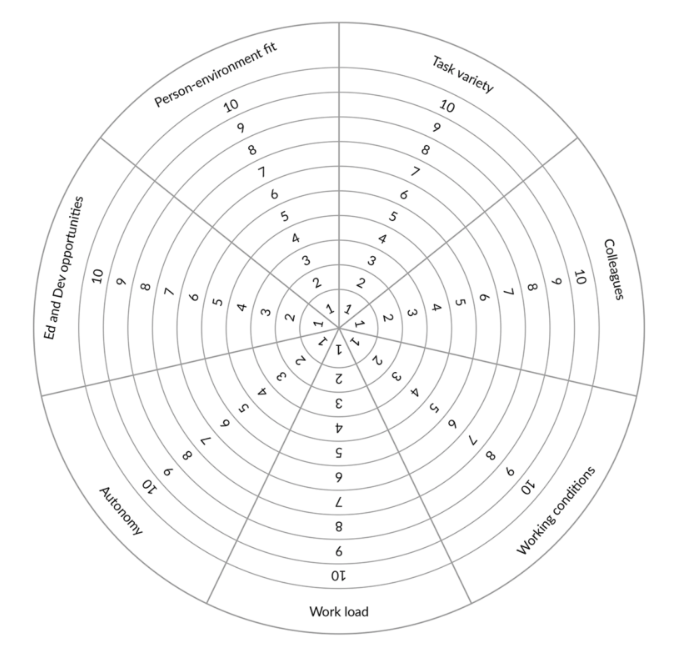How satisfied are you with your work?

Be honest—how satisfied are you with your work right now?
When was the last time you took a step back to assess your level of job satisfaction?
Whether you're self-employed or work full-time, it's essential to regularly check in with yourself to measure your well-being at work.
Over time, our roles and responsibilities shift. Sometimes without us even realizing it. Our work changes and evolves as client needs shift, companies grow, personal priorities develop, and so on.
You may have been super content with your work life six months ago. You were spending adequate time on projects that energized you, working with cool people in an environment that motivated you.
Fast forward to today. Is that still the case?
If not, don't worry. It's entirely normal for our job satisfaction to shift over time. It's a natural part of our professional journey.
The evolution of work-life happiness
Sometimes, a few adjustments are all it takes to realign with your current reality and evolving priorities.
For example, you're a writer who loves the craft. You enjoy hunkering down in a booth at your favorite coffee shop, putting pen to paper (or fingers to the keyboard) to write articles that educate and inspire others.
As time passes, you find yourself writing less as your business grows. Now, you spend most of your day on admin work, managing a small team, zoom meetings, and sales calls.
Sound familiar?
I may or may not be speaking from experience here. 😂
You love that business is going well but miss spending time on your craft each week. What can you do?
Start by breaking down the different parts of your work to see what makes your job satisfying.
Factors that contribute to job satisfaction
Research shows seven factors contribute to job satisfaction, including:
Task variety
The importance of variety in your role depends on your work preferences. For example, if you're self-employed, task variety might be a significant reason you started your business in the first place.
Is your work providing enough variety to meet your needs?
Clients and colleagues
Consider the people you regularly interact with each week. The better we get along with our colleagues, the more pleasant our work becomes.
Do you share similar goals, work ethic, and values with those you spend time working with?
Working conditions
The conditions of your workplace matter. Physical aspects like office organization and cleanliness and cultural factors like team collaboration and atmosphere are crucial to your satisfaction.
Are you working in an environment that's most conducive to you?
Workload
Juggling too much work can eventually lead to a crash. However, having too little to do can also result in boredom and disengagement. Finding the right balance is vital for everyone.
Are you comfortable with the amount of work on your plate?
Autonomy
We need to feel a sense of control over our work, including our work hours, the freedom to propose new ideas, and the ability to choose projects that leverage our strengths.
Are you happy with the level of autonomy you have in your role?
Professional development
The need for growth and development to advance our skills varies among individuals. Some require more access to these opportunities to feel confident and content in their role. This includes learning new skills and making progress within the company.
Are you happy with the growth trajectory of your career?
Person-environment fit
The "person-environment fit" factor refers to how well-suited you are to your work environment. Some people thrive in solitude, while others need a high-energy atmosphere with lots of interaction.
Does your environment allow you to thrive?
Once you've considered how well these seven domains align with your personal preferences, the next step is to map it out.
Complete the job satisfaction wheel
Based on these seven domains, the job satisfaction wheel creates a snapshot of your overall satisfaction with work.

Rate your level of satisfaction across each domain
To complete the job satisfaction wheel, consider your current level of happiness in each of the seven domains. Rate your satisfaction on a scale from 1 to 10, where 1 indicates complete dissatisfaction and 10 indicates high satisfaction. Then, shade in the box on the circle that corresponds to your rating for each category. This will give you a visual representation of your overall job satisfaction.
Connect all of your scores to form your wheel
After you've shaded in a box indicating a rating for each category, your scores should connect and form your wheel. Now, you have a visual overview of your job satisfaction.
Step back and reflect
Take a look at your wheel and identify areas you feel need improvement. Why does this area need attention? What would it take to improve your satisfaction with this area? What actions can you take now to start making improvements?
Revisit your schedule
How can you reorganize your schedule to build time back into your day for what you love?
Depending on your unique situation, you may need to make a drastic change or a small one.
Even making slight adjustments to your schedule to accommodate this work can provide more variety, satisfaction, and access to that elusive flow state everyone's gunning for.
Or maybe you feel uninspired, burnt out, or a bit lost at work, but you're not sure why. You might need a bird's-eye view of all the different domains of work at play to get a clear picture of what's missing.
Whichever situation you find yourself in, the job satisfaction wheel can help.
Add this tool to your arsenal
Whether you're considering a career change or seeking greater fulfillment in your current role, this exercise can help you identify opportunities to enhance your well-being at work by addressing areas that may need improvement.
References:
This tool was adapted from positivepsychology.com and originally developed by Dr. Lucinda Poole and Dr. Hugo Alberts.
- Judge, T. A., & Klinger, R. (2008). Job satisfaction: Subjective well-being at work. In M. Eid & R. J. Larsen (Eds.), The science of subjective well-being (pp. 393-413). Guilford Press.
- Roelen, C. A. M., Koopmans, P. C., & Groothoff, J. W. (2008). Which work factors determine job satisfaction? Work, 30, 433-439.
Dan's Dispatch Newsletter
Join the newsletter to receive the latest updates in your inbox.




